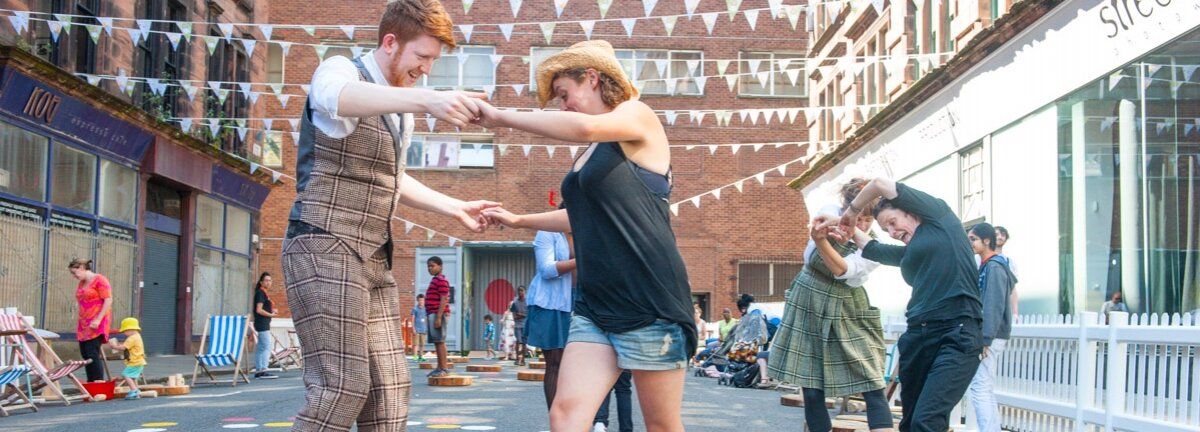How we got Glasgow playing in the streets again

People still love to play on the street – but sometimes it takes careful design to get them started, as we found out while creating Scotch Hoppers for the Glasgow 2014 Games.
Outside my window as I write this, two girls are running and yelling: “you’re trying to catch me”, “nooo, you touched the corner”. A little further down the pavement, they’ve drawn a lopsided hopscotch grid whose squares bend lopsidedly around a tree. And why wouldn’t they? People like to play in public space: on streets, footpaths, in patches of sunlight, dodging around lampposts. Play is a unique and compelling way to relate to your environment, a way of being at home and at peace.
I’m a game designer who creates events and installations to get people playing games in different physical places. Recently I’ve been working with choreographer Brian Hartley and his company Stillmotion on the project Scotch Hoppers, part of the Glasgow 2014 Cultural Programme.
Often, when I talk about playing in public space, people respond as if it doesn’t happen any more: “isn’t it a pity that you can’t play on the street nowadays”. And of course it’s true that many streets are busier now, that there are more digital options for playing, that the norms of where children are allowed to go on their own are more restrictive. But this doesn’t mean people don’t want to play on the street - it just means that sometimes, it takes a little work to get them comfortable with the idea.
We’ve filled the end of Glasgow’s Parnie Street with reimagined versions of traditional street games, from brightly-coloured spots that you jump on, to pieces of wood that you stack on top of each other, to careful wooden installations that you set up and then knock over. It’s been an amazing project to work on, and we’ve learnt a lot about how to get people moving and playing in public.
Communication
People are often afraid of getting things wrong and feeling dumb, so they want to understand what they’re meant to do – so using popular games like hopscotch and skittles as our inspiration was really useful.
Flexibility
It’s really important to allow flexibility in exactly how someone plays. Everyone has different levels of physical agility, and there needs to be scope for them to engage in different ways. The courses we constructed can be navigated in all sorts of different ways: left foot on red spots, right spot on yellow, say, or step only on the red spots, or hold hands in a chain as you move, all suited to different people.
Permission and safety
We’re lucky that Scotch Hoppers is staffed with amazing facilitators who can get people playing in different ways and make sure nothing gets out of hand. Their very presence indicates that the things that are going on are safe, considered, permitted.
It’s harder, but still possible, for physical spaces to indicate this sort of permission without facilitators. The design conventions of playgrounds help us to understand that playing is okay there, for example – and it’s common for playful art installations to borrow this language (everyone loves a swing). However it’s done, a physical indication that play is safe and intended can be key to getting people involved.
Appearance
The colours we used for Scotch Hoppers – red, grey, yellow and white – echo the colours of the street, which is part of why we chose them. But they also have a sense of maturity. Having lots of different bright colours tends to get read as this is for children only, but careful visual signalling can help make adults feel welcome.
Precision
We’ve planned our spotty road, tried countless huge variations, measured and remeasured the distances, compared the gaps between different spots to the stride length of children of different ages, and experimented until we got it right. Every tiny change has big implications for how people play.
So sure, encouraging public play isn’t straightforward! But the reason everyone gets nostalgic about street games is because they’re really, really great.
Playing in public makes you notice things about the environment you wouldn’t notice otherwise, it gets you moving and exhilarated, it helps you lay claim to the places you’re playing in in a very personal way. And we’re very glad to have had a chance to explore that experience in Glasgow.
Subscribe to our newsletter
Want to keep up with the latest from the Design Council?
